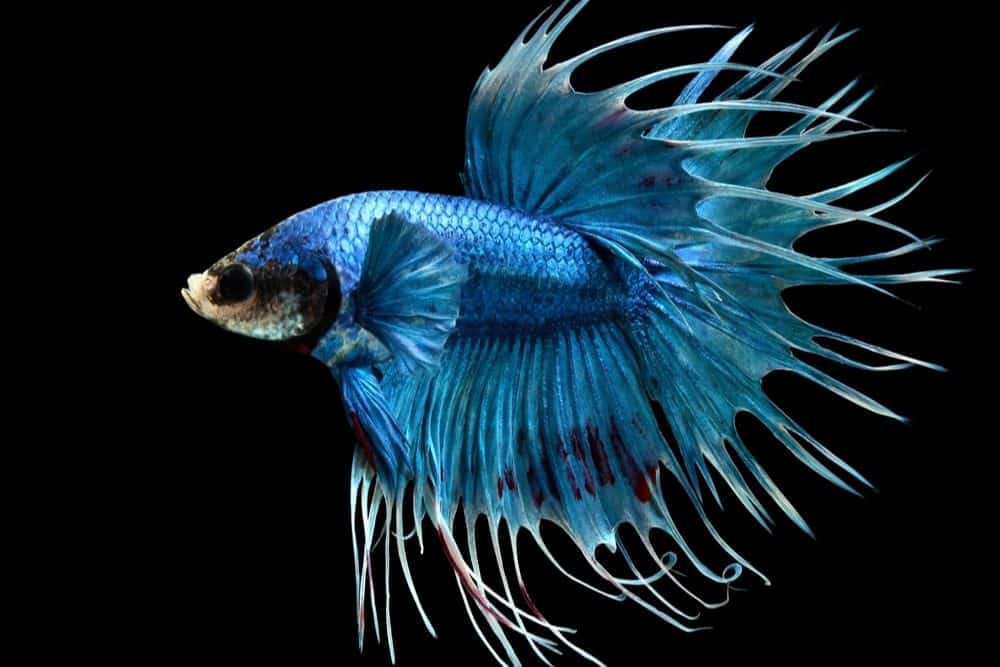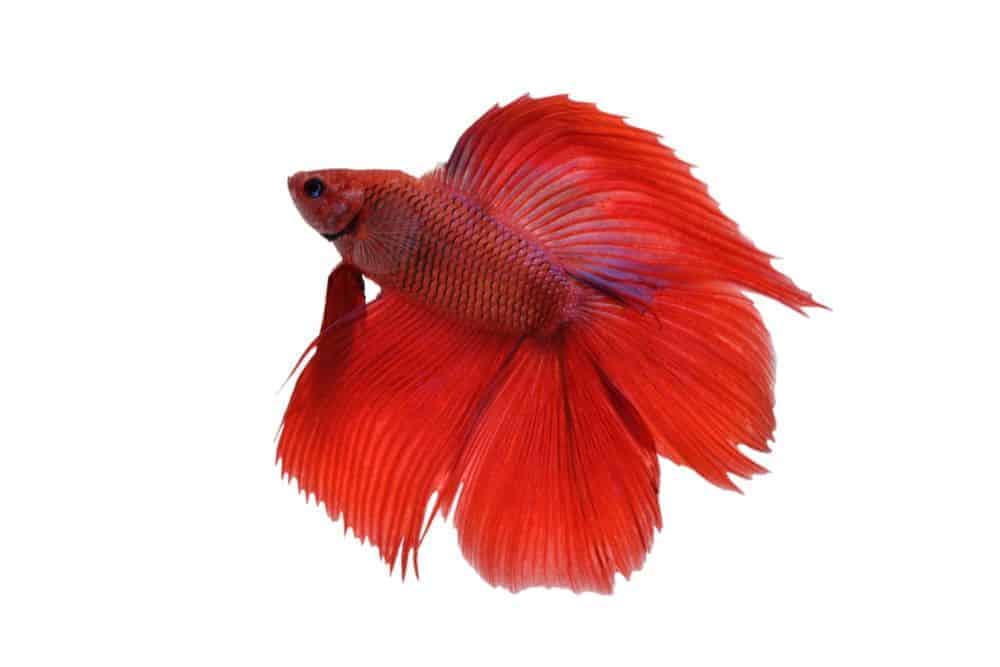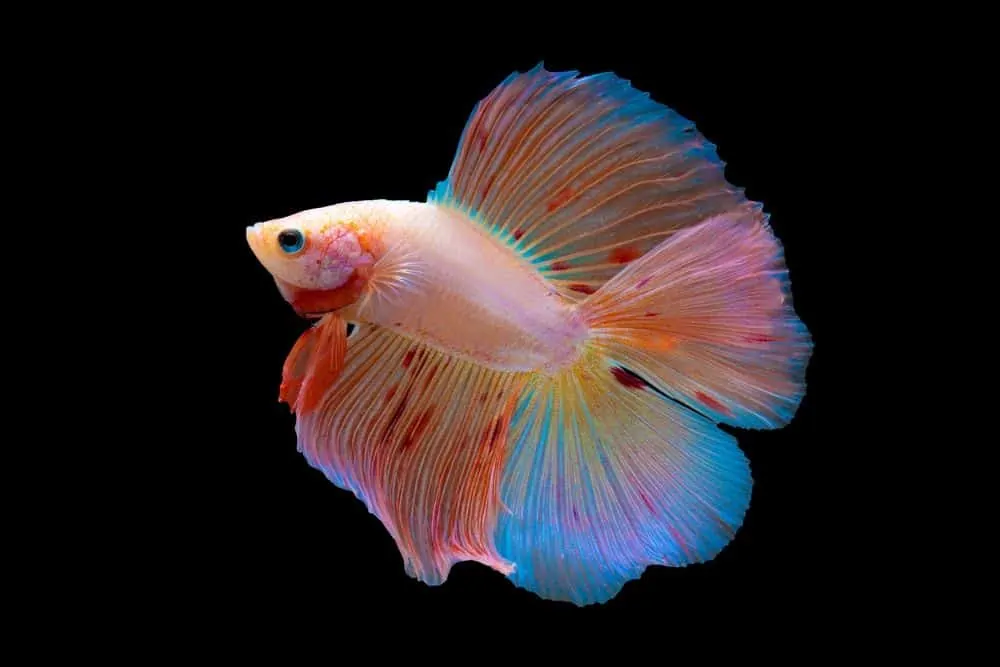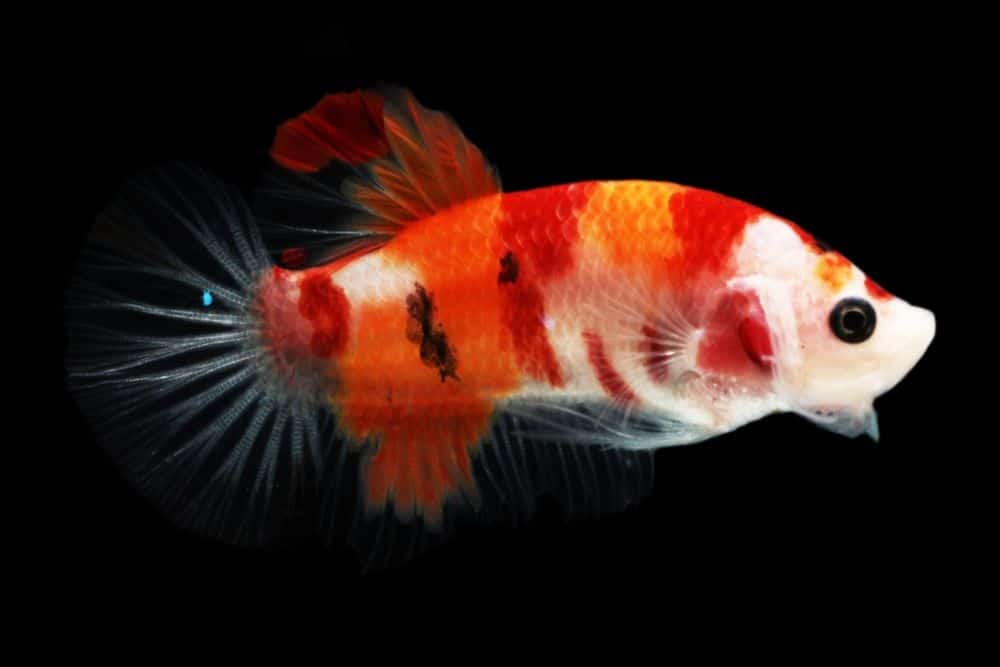Betta genetics could be an entire article on its own. To grossly simplify, bettas have four layers of color in their skin: black, red, yellow, and an iridescent layer. Through breeding bettas whose genes show dominance in various layers of the others, as well as with wild type bettas that have the layers in a different order, bettas now come in a literal rainbow of colors!
Shopping for betta can be confusing, whether online or in a store. The more popular bettas get, the more shapes and colors they seem to come in. To complicate matters, some retailers come up with their own unique names for color variations. This section isn’t an exhaustive description of tail types and colors, but rather a quick reference to help distinguish between kinds.
Tail Types and Colors Of Betta Fish
Betta Tail Types
Plakat Betta

Plakat bettas look closest to the wild type. With their shorter fins and tails, they are sometimes mistaken for female bettas. They tend to have round tails, long ventral fins, and sharp almost angled anal fins.
Veil Tail

This is the most common tail shape and the one you’re most likely to find in pet stores. Their tales are long and flowing and droop slightly. While beautiful, the abundance of Veiltail bettas has lessened their desirability for shows and competitions.
Crowntail

One of the more immediately noticeable bettas, Crowntail have long, spiky fins that almost look like the spikes of a crown. Genetics determine how many spikes branch off of each tail ray, and CT bettas may make more careful care to ensure their tails retain their shape and strength.
Combtail
While combtails have some tail spikes like crowntails, the spikes only protrude out of the end of the fin, not the majority of it. Think a comb with spines, hence the name. They’re usually the result of breeding a CT with another betta type.
Halfmoon

Popular for its beautiful fins, the Halfmoon betta’s tail has a 180° spread, making it look like a “D” or, as the name implies, a half-moon. They also have longer dorsal and anal fins. As with other long-finned betta types, they may have difficulty swimming and be more susceptible to fin tearing and damage from surroundings or tank mates.
Double tail

More uncommon than other bettas, Double tail bettas do not have a tail that was split, but actually two separate tails. Both tails are usually symmetrical. Their bodies are typically shorter than other betta types.
Delta
Delta Betta similar to the Halfmoon, but their tails do not achieve the full 180° spread. These are more common than Halfmoon bettas but still, have a nice amount of fins.
Rosetail / Feathertail

Similar in appearance to the Halfmoon but the ends of the tail look more ruffled due to the way the fin rays branch. Susceptible to the same problems as Halfmoon bettas but look very pretty. A newer development in the betta world, they’re gorgeous to look at but can experience significant problems later in life such as tail/ray breakage, lethargy due to not having the strength to haul their fins around all the time and fin biting out of frustration that leaves them vulnerable to infections.
API STRESS COAT Aquarium Water Conditioner 16-Ounce Bottle
Tetra AquaSafe Plus, 8.45 Ounces, aquarium Water Conditioner And Dechlorinator, Model Number: 46798162681
$10.19 (as of December 16, 2025 09:02 GMT +03:00 - More infoProduct prices and availability are accurate as of the date/time indicated and are subject to change. Any price and availability information displayed on [relevant Amazon Site(s), as applicable] at the time of purchase will apply to the purchase of this product.)API TAP WATER CONDITIONER Aquarium Water Conditioner 16-Ounce Bottle
$8.48 (as of December 16, 2025 09:02 GMT +03:00 - More infoProduct prices and availability are accurate as of the date/time indicated and are subject to change. Any price and availability information displayed on [relevant Amazon Site(s), as applicable] at the time of purchase will apply to the purchase of this product.)Dumbo
Another recent development in betta breeding. Rather than being named for their tails, dumbos are named for their large pectoral fins that look rather like the ears of their eponymous elephant. Dumbo “ears” can be found on any other tail variety, but realize that they can add even more weight and strain to long-finned dumbo bettas.
There are doubtless other types as well, but the above are ones you’re more likely to come across. Also, some of these tail types may be combined with one another, such as the Halfmoon Plakat (HMPK). These have the short fins of the PK but their tail spread reaches the 180° of the Halfmoon, hence the name.
Betta Color Morphs
It’s impossible to list them all since new morphs pop up all the time, but here are a few you’re likely to encounter.
Solid
Precisely what it sounds like! One-color from nose to tail. Red and blue tend to be the most common colors.
Bi-color
The betta’s body is one color and the fins are another. High-quality bi-color bettas do not have any color bleed from the body into the tail.
Cambodian
Technically bi-color betta, the fish’s body is a pale fleshy color and the fins are a deep red.
Butterfly

Popular for their striking looks, these bettas have a solid body and fins with two (sometimes three) bands of color. The fin color closest to the body is typically similar in color to the body, while the outer band is usually white or clear. High-quality butterflies should have an even 50/50 split of colors with a clear line of delineation between them.
Marble
Originally in black and white but now available in almost any color, marbles are a patterned fish most often in two colors. The pattern varies wildly and can change from day to day or over the course of the betta’s life, sometimes even displaying in fish previously thought not to have it.
Koi

Koi bettas are marbles with more than one color, often similar in appearance to koi fish. Most often you’ll find patterns of red and black on the pale flesh color, but new variations are popping up constantly.
Piebald
The bettas will have a pale, flesh-colored face no matter what color the rest of their bodies are. Their bodies are usually mostly solid color, although they carry the marble gene so variations are to be expected.
Multicolor
Very common bettas with an uneven mix of at least three colors on their bodies and fins.
Dragon

These bettas have a strong base color, often red, and scales that look thicker and stronger than other types of bettas that continues all the way to through their head, whereas most bettas have heads that are darker in color than the rest of their scales (when the color covers the betta’s head, this is known as a mask). It is possible for the scales to eventually grow over the betta’s eyes, hampering their vision.
Mustard Gas

Another type of bi-color betta, these fish have either blue or green bodies with orange or yellow fins. May also be called paradise bettas.
Black Lace
A dark black color with some iridescence in their fins.
Melano Black
Carefully bred and fairly rare, these bettas are a deep, solid black color more intense than any of the other black morphs. However, female melano bettas are infertile due to the proteins that cause the deep, faultless black color.
Super Black
A dark black cross between black lace and melano bettas that produces fertile female bettas.
Metallic
Bettas of any color whose bodies and fins are covered in a yellowish iridescent layer. Variations include copper, gold, silver, and more.
Cellophane
Pale-bodied betta with transparent fins.
Summary
Color is probably going to be the biggest thing that attracts you to particular betta, and for good reason! While wild bettas are much plainer in fin shapes and colors, ornamental bettas have been bred in a dizzying array of types and hues. However, be aware that bettas often change color overtime for a couple of reasons.
First, stress makes betta go pale or even develop temporary stripes in extreme cases. Once they get home and settled into a better environment, they’ll often get darker or even change the color entirely! A varied, protein-filled diet can also help them develop good coloration.
Finally, there’s a marble gene present in many bettas that can cause unexpected color change throughout the fish’s life. Some bettas look mottled, to begin with so it’s not necessarily a surprise, but solid-colored betta may carry the marble gene and there’s no way to tell until it changes.

Hi, my name is Sean, and I’m the primary writer on the site. I’m blogging mostly about freshwater and saltwater aquariums, fish, invertebrates, and plants. I’m experienced in the fishkeeping hobby for many years. Over the years I have kept many tanks, and have recently begun getting more serious in wanting to become a professional aquarist. All my knowledge comes from experience and reading forums and a lot of informative sites. In pursuit of becoming a professional, I also want to inspire as many people as I can to pick up this hobby and keep the public interest growing.
Read more about Sean.
Please join also my Facebook group.




















